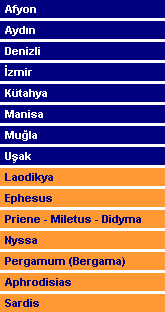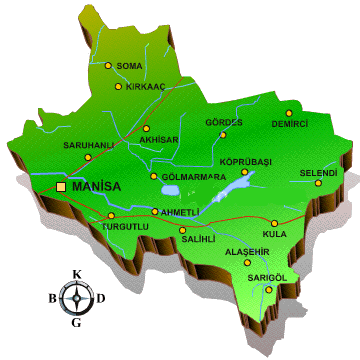| Manisa... |
|
Manisa is an attractive, modern city with a far-reaching past. Its history goes back to 500 BC but the first known
settlements date to the 14th century BC. Since the great Ottoman Sultans chose Manisa as the training ground
for crown princes, there are many examples of Ottoman architecture, as well as Seljuk. The Sultan Mosque of the 16th
century was built for Ayse Sultan, mother of Suleyman the Magnificent. In her honor, the Mesir Macunu Festival (Spiced
Candy which is supposed to restore health, youth and potency) is held every year in March, in the grounds of this mosque.
The Muradiye Mosque of the 16th century was built by the great architect Sinan, and the Murad Bey Medresse now
houses the Archaeological Museum of Manisa. Manisa celebrates the annual Vintage Festival every September, when bringing
in the fruits of the vineyards is celebrated with excitement. The vineyards surround the city and provide dry fruit for
export and grapes for wine making. The Spil Mountain National Park is a cool spot with a richly forested area, hot springs
and a profusion of flowers, especially wild tulips. There are about 120 kinds of endemic plants here. You may go mountaineering
or camping in this area as well as seeing the famous "crying rock" of Niobe, and the carving of Goddess Kybele.
Sardis, in Manisa-Salihli is one of the most remarkable sightseeing areas of Türkiye. It is the ancient capital of Lydia,
once ruled by King Croesus, who was the first one to use coinage in exchange for goods. Since Sardis encountered
earthquakes, most of the remains date back only to Roman times. There are the remains of the temple of Artemis and a
restored gymnasium, exhibiting of the past splendor of this ancient city. The splendid Synagogue from the 3rd
Century is worth visiting, with its elaborate mosaics and artfully carved colored-stone panels. At Sindelli village there
are the fossil foot prints of mankind, belonging to the period of 25-50-century BC. The ruins of the ancient city of
Philadelphia lie in the Alasehir area. Houses at Kula are beautiful examples of Ottoman architecture. For the worshippers
of beautiful carpets, Yunt Dagi, Gordes, Kula and Demirci are famous for their precious carpets, rugs and kilims. In
addition there are many thermal springs throughout the area.
|
|

|


 236...
236...
 45...
45...
 1,260,169...
1,260,169...
 13,810...
13,810...
 27 E 26 - 38 N 36...
27 E 26 - 38 N 36...




